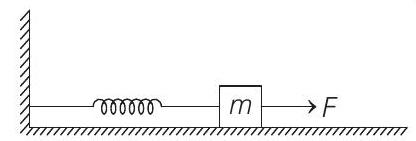Simple Harmonic Motion 4 Question 4
4. A block of mass
(2019 Main, 09 Jan I)

(a)
(b)
(c)
(d)
Show Answer
Answer:
Correct Answer: 4. (b)
Solution:
- In a spring-block system, when a block is pulled with a constant force
In that case, force on the system is given as,
where,
Now we know that, for a system vibrating at its mean position, its maximum velocity is given as,
where,
Since, the block is at its mean position.
Alternate Method
According to the work-energy theorem, net work done
Here, net work done






